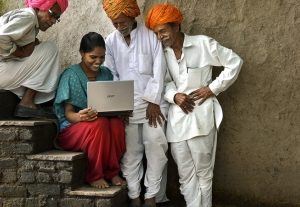In India’s turmeric value chain, women perform over 80% of the labor, including land preparation, weeding, harvesting, cleaning, boiling, drying, peeling, grinding, and packaging — grueling and labor-intensive work. CGAP, the IFC’s Agribusiness Leadership Program, and Samunnati—a member of ABERA, a collaboration between CGAP and IDH that aims to improve the climate resilience of service providers and the rural women they serve—recently visited Araku Valley in Andhra Pradesh and Samastipur in Bihar. During the visit, they observed firsthand the grueling, manual nature of turmeric processing.
The roots are typically dried in the sun. Once dry, the outer skin of the turmeric root is removed to reveal the bright orange-yellow flesh inside. This is rarely mechanized but done by hand, as is the grinding of the root. The women spoke of the damage and pain to their hands from hours of scraping off the outer skin of the turmeric roots, which can be rough and cause strain over time. Repetitive motion often leads to muscle fatigue, joint pain, and blisters. From picking to polishing, it takes around one month to process just one acre of turmeric.
To ease the burden on women and free up their time for other activities, ABERA is working with Samunnati to help farmer-producer organizations (FPOs) and farmers access finance for climate-smart, mechanized tools such as solar dryers, polishers, and peelers.
Solar-powered peelers could significantly improve turmeric processing by automating the peeling process while using sustainable energy and saving women the effort of removing the tough skins with knives. They could reduce labor intensity, save time, and ensure uniform peeling, leading to a higher-quality product. Similarly, solar dryers could reduce drying time and improve quality—drying the turmeric in a controlled environment better protects it from dust, dirt, and contamination, ensuring a cleaner, higher-value product with better shelf-life. The automation of the drying process could reduce spoilage, allowing farmers to process more turmeric with less effort. The resulting higher-quality products could enable farmers to command a higher price for their products, ultimately increasing their income.
Women smallholder farmers, including those in India’s turmeric value chain, have seen increased incomes through the use of dryers (not yet solar dryers), which add value to their products, help preserve nutritional content, and support environmental sustainability. Take Moomba, a social enterprise in India focused on reducing post-harvest losses and empowering women farmers, which has contributed to approximately 15-20% income elevation of around 3,500 women farmers while mitigating 1.2 million tons of carbon dioxide emissions.
In addition to the benefits mentioned above, there are environmental (reduced carbon footprint, improved air/water quality, resource conservation, waste reduction, and less reliance on fossil fuels) and economic (cost savings through reduced energy bills, potential job creation, increased competitiveness, and improved brand reputation) benefits of adopting climate-smart tools. This has also captured the attention of the Government of India, which is promoting the use of solar technology through its Pradhan Mantri Kisan Urja Suraksha evam Utthan Mahabhiyan (PM-KUSUM). This is a major initiative aimed at empowering rural farmers by promoting solar energy use in agriculture. This scheme is primarily focused on providing or subsidizing irrigation pumps, prioritizing small and marginal farmers, helping them reduce input costs and gain energy independence, which in turn will improve their well-being.
While green technology is good for the planet, it is also essential for productivity in rural India. Even though India is officially considered ‘100% electrified’, this classification only requires that 10% of households in a village be connected to the grid. In practice, many rural communities still lack reliable power and often rely on costly diesel generators. Even with access to electricity, there are outages—for mechanization to work effectively, it needs uninterrupted processing. Solar can provide this, even in extremely rural, off-grid areas. This green innovation would significantly boost women’s productivity, allowing them to process more turmeric with less effort and increase their earnings.
In the coming months, CGAP and IDH will work with Samunnati as part of the ABERA partnership to explore how financial services—particularly blended finance instruments—can unlock access to green technology at the last mile. This includes tools such as credit guarantees and outcome-based tools like social success notes. These are innovative financing agreements where investors or donors agree to provide better terms—or even partial repayment—if measurable social goals are met, such as increased incomes for women or wider adoption of solar dryers. The partnership will also assess what non-financial support—such as awareness-raising, training, and skill-building—is needed to help farmers adopt these innovations and benefit fully from them.
We invite you to join us on our journey as we explore how financial innovation can support women smallholder farmers in the turmeric value chain and the FPOs that serve them. After all, these tools must ultimately deliver real financial and well-being gains for the people who need them most.
This blog builds on previous ABERA analysis on Samunnati’s business model, carried out by IDH and CGAP.


